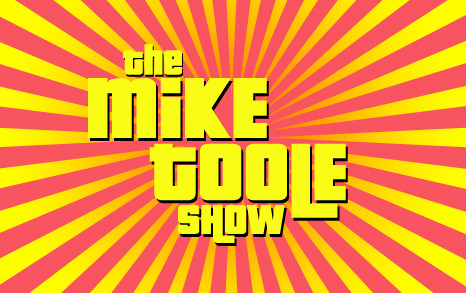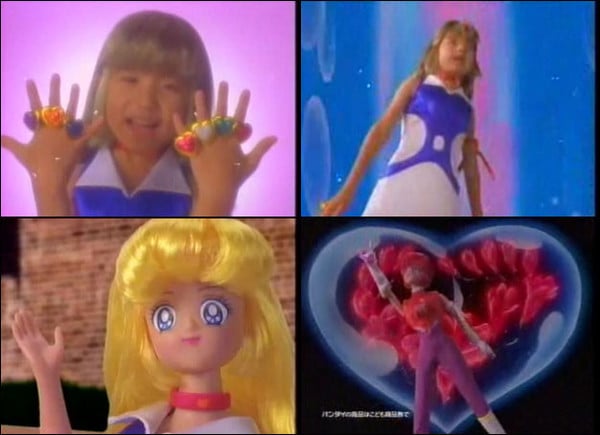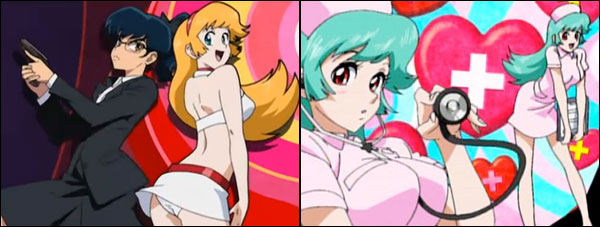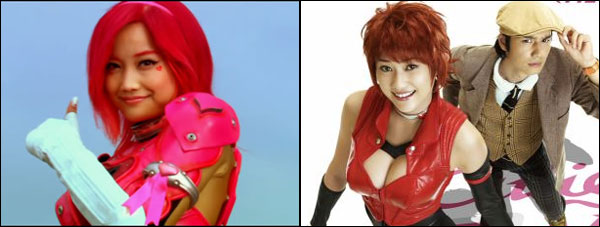The Mike Toole Show
A Bit 'O Honey
by Michael Toole,
Sometimes, it's hard to come up with a good subject for these damn things. My previous column, all about the weird connections between Gobots, Machine Robo, and Transformers, started off as another Super Robot Island installment before abruptly mutating into a treatise on wacky cartoon robot cross-importation. Obviously, the thing to do was to push Super Robot Island to this week's entry, but hang on-- I just did a column about robots! Clearly, I need to mix it up a little.
Fortunately, a good subject presented itself yesterday when our pals at Discotek Media announced plans to release Gō Nagai's Mazinger Z and Cutey Honey on DVD next year. Discotek do lean pretty heavily on the nostalgia angle, which I have a weakness for, but I kinda love the way they stand in stark defiance of the old “never release really old stuff, because unfortunately nobody buys it” rule. Anyway, I could pretty much write an entire column about the Banpresto Mazinger Z arcade game-- and again, I just did a column about robots-- so I figure this one can be about Cutey Honey instead.

Maybe it'd be a bit more apropos to focus on the full body of work of one Gō Nagai, the guy who created both Honey and Mazinger. But I'm not even sure I could sum up all of Nagai's stuff in a single piece, simply because the he's been cranking material out since the sixties-- and even moreso than contemporaries like Osamu Tezuka and Takao Saitō, Nagai changed the dynamics of the manga business with his company, the appropriately-named Dynamic Pro, which he founded after getting stiff-armed on royalties from his first big hit, Harenchi Gakuen. So pretty early in the game, Nagai found himself with not just several talented assistants ready to turn his ideas, concept sketches, and panel roughs into full-blown manga, but an entire office staff to manage his characters and brands. As a result, he turned out literally dozens of titles per year, and is one of only a small handful of manga artists to run no less than five ongoing serials concurrently at a few points in his career.
If you ask most anime fans about Cutey Honey, maybe they'll be able to talk a bit about the story, featuring brave schoolgirl Honey Kisaragi facing off against the nefarious Panther Claw organization and its leaders, Panther Zora and Sister Jill. Or they'll hum a section of the catchy, remarkably persistent theme song, which is present in every screen version of the series and holds a stature somewhat akin to the iconic themes of fare like Lupin the 3rd, Space Battleship Yamato, and Gegege no Kitarō. Or maybe they'll mention that Cutey Honey was kind of a game-changer, an early magical girl story that popularized the idea of a “henshin” sequence where the heroine undergoes a stylized stock-footage transformation into her super-powered self. Indeed, what makes Honey's henshin sequences stand out is that she pretty obviously loses her clothes in between them-- so to a lot of fans, Cutey Honey isn't really a thing for small children.
The funny thing is, Cutey Honey totally started off as a thing for small children! The series’ origins in 1973 came during a period when Nagai and his studio weren't doing a lot of shoujo manga, but Nagai was by no means a stranger to comics for girls. Like peers such as Leiji Matsumoto and Mitsuteru Yokoyama, he did plenty of work for the likes of Nakayoshi and Shoujo Friend in the late sixties, writing and drawing brief gag-driven comics with titles like Pansy-chan and Mari-chan's Dream World. But in ‘73, Nagai was coming off the success of Mazinger Z, which yielded not just a popular cartoon, but a bonanza of cash from toy and merchandise sales. Clearly, the thing to do was to follow this angle in a similar product aimed at girls instead of boys, and so Nagai planned Cutey Honey, the story of a teen girl who discovers that her super-scientist dad built her (she's an android!) and gave her fabulous secret powers-- the powers to change, at will, into a variety of exciting costumes and identities, like TV reporter, pop singer, and stewardess! A manga serial was planned for Ribon magazine, a series of neat dolls with quick-change outfits was discussed, and the show was positioned to slide right into a plum 7pm slot on NET, which was Toei's usual spot for magical girl fare.
But along the way, things changed unexpectedly. That space was given to Miracle Girl Limit-chan instead, and Honey got bumped to a later timeslot that had just hosted Nagai's Devilman, so the series would have to be retooled for shonen sensibilities. Amusingly, Nagai didn't change too much of the plot-- he just suggested that Honey's transformation sequences be a bit racier, and cranked up the bawdy jokes and slapstick in his one-shot manga version, which shifted to Shōnen Champion. Popy released a few toys, notably a Rider Honey motorcycle, but those planned dolls never appeared on shelves to compete with Licca-chan. A couple of short comics were also scripted by Nagai and drawn by shoujo artists during the show's broadcast in ‘73 and ‘74, but that was about the extent of Cutey Honey’s original “for girls!” angle.
That isn't to say that the resulting Cutey Honey TV series was some sort of goofy, adolescent-boy raunchfest. The naked transformation sequences were strictly Barbie-doll fare, and Nagai's manga tale, in which comely Honey is the objet d'affection for not just potential boyfriend Seiji but most of her female classmates and teachers, was toned down quite a bit for the small screen. Honestly, I'm curious about how well fans are going to receive a 35-year-old series that, for all its importance in establishing magical girl genre conventions, is awfully zany, with gags and chase scenes that remind me more of Scooby Doo than Nagai's seminal robot and action fare of the 70s. At the end of the day, though, Cutey Honey is still the adventures of a pretty robot girl who dons a skintight outfit to fight the forces of evil with a goddamn sword, so I'm looking forward to it.

Nagai did manage to pull off a full-press magical girl show with 1978's Majokko Tickle, but Cutey Honey pretty much took the 1980s off. Nagai and Dynamic busied themselves with fare like X-Bomber, Jūshin Liger, and that one manga about the girl superhero who wears underpants on her head, and Honey stayed on the back burner until a new manga series by Nagai debuted in 1992. This series actually came out in English via Studio Ironcat, under the somewhat misleading title of Cutie Honey ‘90. Check it out if you want to see sloppily reprinted comics that feature Nagai pretty much going through the motions. But 1994's New Cutey Honey OVA would bring the franchise's profile way up.
Interestingly, aside from those crummy comics, New Cutey Honey is the only version of the series that's gotten release in the west-- it was an early ADV Films offering. It managed to do pretty well here, too-- the company kept it in print for something like fifteen years, and I remember a late-90s marketing campaign touting the dubbed version, which featured Jessica Calvello, selected by Nagai himself from a pool of Texas voice actresses, in the title role. I'm pretty fond of this series-- it's aimed squarely at nostalgiacs and the seinen demographic. Recasting Honey as the secretary to the mayor of a corrupt future city, it ups the fanservice quotient considerably, and is otherwise a fun, action-packed champloo of Honey tropes and elements of Nagai's other works-- watch closely, and you'll spot references to Mazinger Z, Devilman... even bits of the infamous Violence Jack make it in.

Then, more than twenty years after the original plan to make Cutey Honey a role model for little girls across Japan was scrapped, the old plan finally came to fruition with 1997's Cutey Honey Flash. The look of this 39-episode series is amusing; the characters are clearly tweaked for shoujo sensibilities, but Honey retains her bodaciousness from Nagai's original works, which is all the more humorous when you start sniffing around and find old TV commercials for the many, many dolls and other toys that Cutey Honey Flash yielded.

Yep! Anyway, Cutey Honey Flash was slotted into the “Golden Time” slot right after Sailor Moon Stars wrapped, so its success was always pretty likely. But Toei did a good job with the series, which was zippy and fun; the game was changed by tweaking the plot to make Honey a human with super powers, and the show also introduced a rival and partner for Honey, the mysterious Misty Honey, along with a variety of somewhat less ferociously gendered trasformation forms (the stewardess transformation, which bears the somewhat eyebrow-raising moniker “Escort Honey,” is still present, though). Best of all, the full shoujo-ization of the series still didn't prevent numerous classic Gō Nagai references from sneaking in. My favorite? Gorgon Claw, one of the show's bad girls, is a female version of one of the beefy, scary monster baddies from Mazinger Z. Check it out!

I somehow managed to see the majority of this show on VHS fansubs-- remember those? No, of course you don't. But what Cutey Honey Flash managed to do, aside from causing certain atrocities and unleashing a flood of neat plastic junk in TOYS R US stores across Japan, is give the franchise some serious staying power. After Flash, Cutey Honey has stuck around in one manga form or another almost continuously, and she was given the live-action treatment in a 2004 movie directed by Hideaki Anno.
Yeah, that Hideaki Anno-- the Evangelion guy! Admittedly, this wasn't too much of a stretch-- Anno and his GAINAX cohorts got their start with fare like the amusing Ultraman Returns fan film, and he'd made his live-action directorial debut with 1998's Love & Pop. What Anno gives us in 2004's Cutie Honey movie is a fairly by-the-book retelling of the Honey story: trasforming super-android Honey squares off against the evil Panther Claw organization with the help of her pals Nacchan and Seiji, who are a policewoman and a reporter instead of students this time. Model Eriko Sato looks great in the costume, and Anno does a fairly good job with what looks like a pretty damn low budget, imbuing the film with a campy, 1960s-Batman feel. The film is good fun, but I'm fond of it mainly because it leads right into Re: Cutie Honey.

I mentioned Re: Cutie Honey in a column a ways back about neglected mid-2000s anime. A couple of years on, Re: Cutie Honey is still sadly neglected. Ostensibly helmed by Anno, this 3-partner is really an excuse for the director to turn his hyperactive animation director team of Hiroyuki Imaishi, Naoyuki Itou, and Masayuki Yamaguchi loose on the franchise. I love the OVA's creative, wildly colorful look, and its weird spin on the Honey tale; its characterization of put-upon sidekick Nacchan as a fiery, irritated policewoman is my favorite in the franchise. In fact, the only real problem with Re: Cutie Honey was pointed out to me by a pretty girl in a Cutey Honey costume at this year's Otakon. She liked the OVA too, but had misgivings about the way it potrayed Honey herself-- because she's kind of stupid in this one. That's too bad-- Honey's a merry prankster in Nagai's original work, she's a valiant, self-sacrificing heroine in New Cutey Honey, and she's a pretty nice girl in Cutey Honey Flash, so there's no real reason to make her an airhead. Oh, well. I still want this damn thing on DVD!
To bring things home, Honey would make an interesting return to live action in a 26-episode tokusatsu series in 2007, entitled Cutie Honey: The Live. This series maintains many proud tokusatsu traditions, like questionable acting, cheesy dialogue, and weird-looking CG and composite special effects-- but it also has the good tokusatsu stuff, like fun fight scenes, entertainingly epic storytelling, and fabulous costumes. (If you ask me, series lead Mikie Hara looks even better as Honey than Sato in the film. I think it's the wig..) Cutie Honey: The Live ups the ante as well, by turning our heroine into the central figure of a whole trio of butt-kicking super androids, making the red-clad Honey the de facto leader of blue-wearing Sister Yuki and white-clad Sister Miki. Don't miss bona fide stuntman and martial artist Mark Musashi as one of the bad guys; he gets to swear in English a lot!

I've always found Cutey Honey interesting to think about. Not only can we all argue about whether to spell it “Cutey” or “Cutie,” the story that drives Gō Nagai's manga and animation and cinema is both quite empowering and a little sexist. Honey frequently resorts to playing dress-up as a model or stewardess (heck, one of her big final transformations in Cutey Honey Flash is as a bride-- shades of Wedding Peach!) and gives both the audience and her adversaries an eyeful every time she transforms, but at the same time, her “true” form, the redhead in the form-fitting getup, is a confident, trash-talking swordswoman who fights against evil and wins. And okay, sometimes the powerful Honey still needs rescuing from Seiji and her other pals, but Nagai himself is quick to point out that, before her, there weren't any popular shonen manga or anime that featured a girl as the main character. Still, one wonders if the next reboot (just wait, we'll get it eventually!) would be improved by putting aside the torch singer and nurse getups in favor of atomic scientist Honey or CEO Honey. All I can leave you with this this enduring image of a good girl fighting valiantly against evil.

So which of Honey's costume quick-changes is your favorite? Which version of the cartoon and live-action stuff is the best one? Sound off in the comments!
discuss this in the forum (17 posts) |